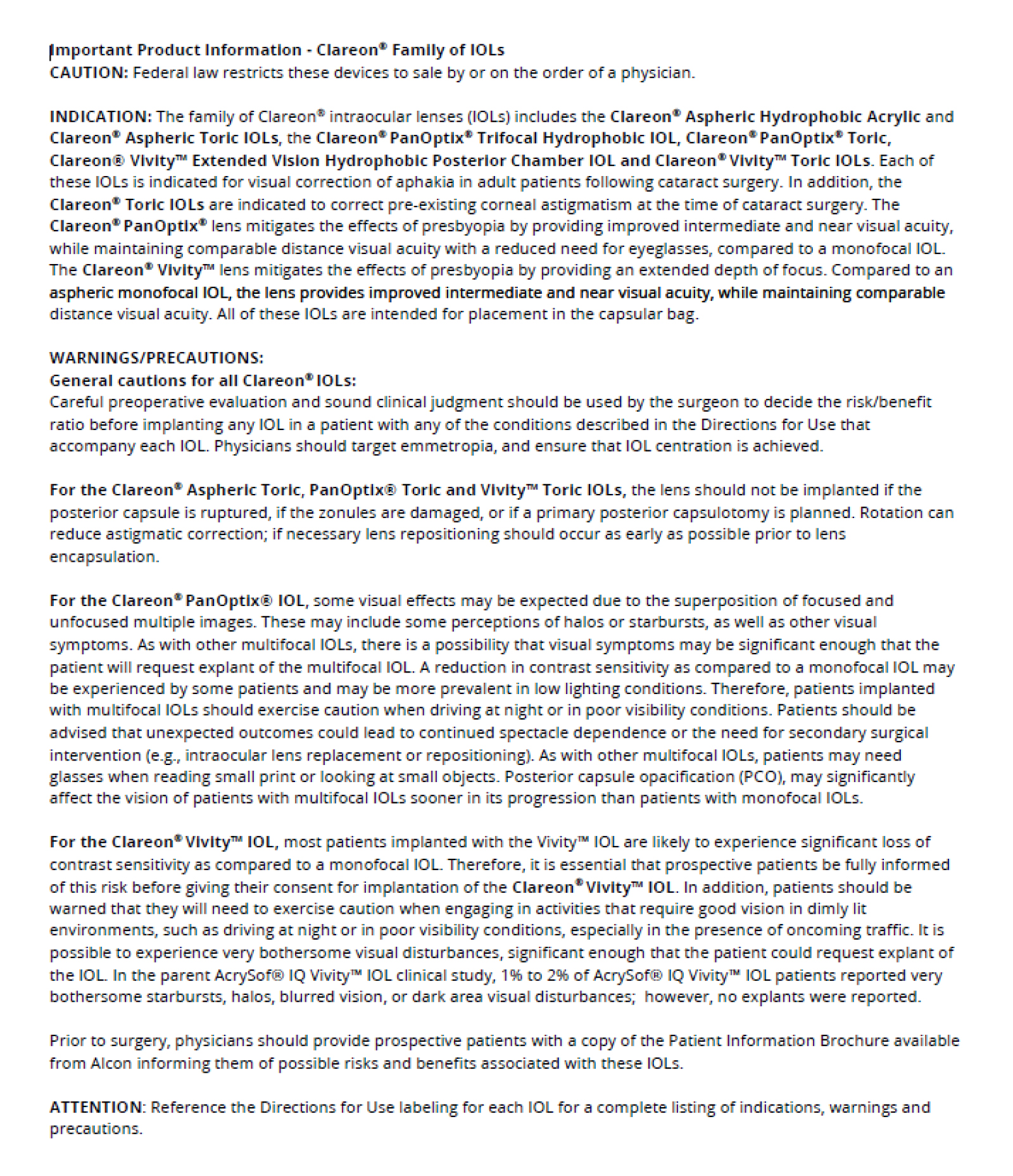
The incredible proliferation of intraocular lens (IOL) implants continues to gather speed around the world – an Alcon IOL, for example, is implanted in an eye every four seconds. However, there are still some misconceptions around cataract surgery that can confuse patients and surgeons alike (1).
This was the theme of a seminar hosted by Canada’s Ike Ahmed, MD, FRCSC, for a packed audience of cataract and refractive surgeons at this year’s ESCRS Congress in Barcelona, Spain (6-10 September, 2024). Featuring expert contributions from the US and Europe, “Breaking Barriers on Presbyopia Correcting Surgery” sought to highlight the reasons for choosing one presbyopia-correcting intraocular lens (PC-IOL) over another, clarify the classification of different IOLs, and most importantly, emphasize the importance of clearly communicating the value and benefits of particular IOLs to patients.
PanOptix
The patient communication issue was underscored by an audience poll that showed that a key challenge regarding PC-IOL utilization was the “lack of time to educate patients and involve them in the decision-making process.” Addressing this point, Satish Modi, MD, FRCSC, a surgeon in private practice in Poughkeepsie, New York, highlighted the importance of really getting to know one’s patients and their daily needs before educating them on IOLs. Some well-informed patients come to the ophthalmologist’s office with strong, preconceived ideas about IOLs, so the surgeon needs to “un-educate them and then re-educate them,” he observed. And it’s not just vital that patients know about all the options available to them – e.g., monofocal, trifocal, EDOF – but that the surgeons themselves have a thorough knowledge of what is available and what different IOLs can do.
For example, in terms of addressing visual disturbances, especially severe disturbances, Modi pointed to a recent study showing that the trifocal AcrySof® PanOptix® IOL demonstrated a higher percentage of patients not experiencing or not at all bothered by visual disturbances of starbursts and glare compared to the extended depth of focus (EDOF)/multifocal TECNIS Synergy IOL (p<0.05). Additionally, results in patients bilaterally implanted with the PanOptix and Synergy IOLs also indicated that the PanOptix provides a similar range of vision compared to the Synergy from distance to near (33 cm) under photopic and mesopic conditions(2).
Vivity
Discussing EDOF lenses specifically, Sarah Maling, MD, Pediatric Ophthalmology and Strabismus Lead and Joint Lead for Cataracts at Buckinghamshire Healthcare NHS Trust, presented cases for “turning the page” on EDOF. Based on her experience with Vivity® lenses, Dr. Maling said, “There are times now when you should be thinking about EDOF when perhaps you wouldn’t have done in the past.” She highlighted that surgeons should help patients understand what a starburst or a halo is, for example, and understand what their vision is going to be like after surgery. Echoing Dr. Modi’s point, she added that the surgeon needs to know what their patients do every day – their hobbies, their activities, their requirements – in order to best prepare them for the outcome.
Dr. Maling highlighted two cases where she successfully implanted Vivity lenses in unilateral cases: a 76-year-old man with reduced vision and a 28-year-old man with a left cataract. She explained that EDOF lenses are not “only for people with perfect eyes.” Thanks to Vivity’s wavefront-shaping technology, even patients with some degree of ocular pathology can achieve excellent outcomes. Dr. Maling pointed out that a growing body of research supports using EDOF lenses instead of monofocals in these cases. For her, Vivity represents a significant advancement in presbyopia correction for a broader range of patients. “It is a ‘REAL’ EDOF lens,” she observed – in this case, REAL standing for (3):
Revolutionary wavefront-shaping X-Wave™ technology (“which means it works”)
Extended range of vision (these cases showing “excellent distance, intermediate and functional near vision”)
ANSI and ISO standards (which the Vivity “meets and exceeds”), and
Low rate of visual disturbance.”
Clareon monofocal and toric
Edoardo Ligabue, MD, Chief of the Cataract and Refractive Department at the Centro Diagnostico Italiano in Milan, Italy, outlined options available to ophthalmologists when a presbyopia-correcting IOL is not an option – for example, with patients with severe dry eye disease, severe maculopathy, and irregular or ectatic cornea. In such cases, Dr. Ligabue recommended choosing a monofocal IOL such as Clareon®. Citing a recent study by Micheletti et al., Dr. Ligabue noted that there was no significant difference observed in the range of vision between Clareon and the TECNIS Eyhance monofocal IOL. This was a non-interventional, examiner masked comparative study (n=155 per group) on binocular visual acuities at distance and intermediate. In this study, non-inferiority (1 EDTRS line) was confirmed with step down statistical analysis of multiple visual acuities. He pointed to a further prospective, evaluator-masked study (Blehm and Hall) showing that Clareon IOL can provide stable refraction, excellent distance vision, and range of vision postoperatively that was consistent with the Micheletti et al. findings (4, 5, 6, 7).
Sharing a surgical case of a patient implanted with Clareon toric, Dr. Ligabue also pointed out that Clareon toric provides the same benefits as Clareon monofocal in terms of consistent visual outcomes, with the addition of astigmatism correction (7).
Like Dr. Modi and Dr. Maling, Dr. Ligabue emphasized the importance of patient communication. To help convey this information to patients, Dr. Ligabue recommended using the Alcon Smart Educator. Patients who are looking for consistent, excellent intermediate vision should consider a PC-IOL instead (4,5).
Concluding the seminar, Dr. Ahmed thanked the speakers for “addressing some of the challenges around PC-IOL lenses and clearing up some of the classifications.” He added: “Between Vivity, PanOptix, and Clareon, I think we have a wide variety of options to serve the vast majority of our patients.”
For important product information on PanOptix, Vivity, Clareon monofocal and Clareon toric, please see your local Directions for Use, or visit MyAlcon.com. Refer to operator’s manual for a list of indications, warnings and precautions.
Download important product information as a PDF

© 2024 Alcon Inc. GLB/IMG-CLI-2400011
References
- Alcon Data on File, 2023.
- S Modi et al., “Comparison of Visual Function Between Two Presbyopia-Correcting Intraocular Lenses: A Randomized Bilateral Study.” Paper presented at ASCRS Annual Meeting, Boston, April 5-8, 2024.
- Clareon Vivity Directions for Use
- Clareon Monofocal Directions for Use
- JM Micheletti et al., “Head-to-Head Comparison of Intermediate Vision of Two Monofocal Intraocular Lenses,” Clin Ophthalmol., 21, 3983 (2023). PMID: 38146452.
- C Blehm, B Hall. “Evaluation of Visual Outcomes and 3-Month Refractive Stability of a New Hydrophobic Acrylic Intraocular Lens,” Clin Ophthalmol. 17, 1859 (2023). PMID: 37425027.
- Clareon Monofocal Toric Directions for Use
